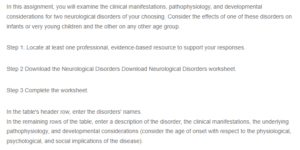Neurological Disorders – Attention Deficit Hyperactivity Disorder and Alzheimer’s Disease
Do you need urgent assignment help ? Get in touch with us at eminencepapers.com.
| Attention Deficit Hyperactivity Disorder (ADHD) | Alzheimer’s Disease | |
| Description of the disorder | ADHD is a chronic neurodevelopmental disorder in which children find it hard to sustain attention. They also become overactive, have trouble controlling their impulses, and find it hard to organize themselves for their age or even follow through with conversations and routines (CDC, 2022). | Alzheimer’s disease is a progressive type of dementia that develops from mild loss of memory to inability to control language and speech, affecting the patient’s ability to maintain conversations and respond to the environment and causing total loss of the ability to perform daily living activities (Kumar et al., 2022). |
| Clinical Manifestations | Children with ADHD usually forget easily, become talkative, and may find it hard to resist distraction (CDC, 2022). They may also manifest behaviors of carelessness, taking unnecessary risks, and inability to get along with others or make friends. | Common manifestations include memory problems leading to the inability to perform activities of daily living, repeating questions and statements, poor judgment, losing things, and mood and behavior changes. |
| Underlying pathophysiology | ADHD can be genetically inherited (Yao et al., 2019). Other underlying neuropathology of ADHD includes brain injury, exposure to lead, exposure to tobacco and alcohol before birth, and prematurely born children (CDC, 2022). | Alzheimer’s disease can be inherited or arise as a result of an overabundance of aberrant neuritic plaques, neurofibrillary tangles, or granulovacuolar degeneration of hippocampal pyramidal cells caused by amyloid angiopathy (Kumar et al., 2022). |
| Developmental Considerations | Developmental considerations for ADHD in children may include their level of activity, social and mental development by the age of 12 years, motivation towards activities, attention span, and how they perceive themselves. Some considerations are noticeable by the age of 3. | Usually, a consideration of people at 65 years old and above includes their ability to maintain memories in the short-term and their ability to perform activities of daily life such as self-care, including hygiene, eating, and use of toilets. Other considerations include their motor abilities and level of disorientation. |
References
CDC. (2022). What is ADHD? Centers for Disease Control and Prevention. https://www.cdc.gov/ncbddd/adhd/facts.html
Kumar, A., Sidhu, J., Goyal, A., & Tsao, J. W. (2022). Alzheimer Disease. StatPearls, 1–27. https://www.ncbi.nlm.nih.gov/books/NBK499922/
Yao, S., Kuja-Halkola, R., Martin, J., Lu, Y., Lichtenstein, P., Hübel, C., Almqvist, C., Magnusson, P. K., Bulik, C. M., Larsson, H., Norring, C., Birgegård, A., Norring, C., Birgegård, A., Almqvist, C., Larsson, H., Martin, J., Hübel, C., Yilmaz, Z., Bulik, C. (2019). Associations Between Attention-Deficit/Hyperactivity Disorder and Various Eating Disorders: A Swedish Nationwide Population Study Using Multiple Genetically Informative Approaches. Biological Psychiatry, 86(8), 577–586. https://doi.org/10.1016/J.BIOPSYCH.2019.04.036
ORDER A PLAGIARISM-FREE PAPER HERE
We’ll write everything from scratch
Question
In this assignment, you will examine the clinical manifestations, pathophysiology, and developmental considerations for two neurological disorders of your choosing. Consider the effects of one of these disorders on infants or very young children and the other on any other age group.

Attention Deficit Hyperactivity Disorder and Alzheimer’s Disease
Step 1: Locate at least one professional, evidence-based resource to support your responses.
Step 2 Download the Neurological Disorders Download Neurological Disorders worksheet.
Step 3 Complete the worksheet.
In the table’s header row, enter the disorders’ names.
In the remaining rows of the table, enter a description of the disorder, the clinical manifestations, the underlying pathophysiology, and developmental considerations (consider the age of onset with respect to the physiological, psychological, and social implications of the disease).

